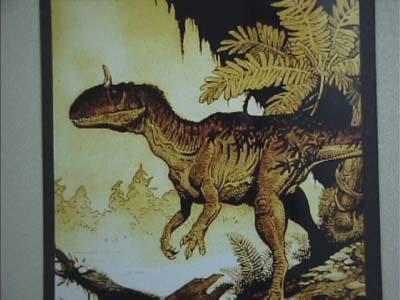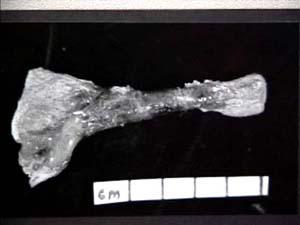25 January, 2001
If you could travel back 135 million years in EarthÝs history you would
find a place that resembles no ecosystem on the planet today. For starters
there were no grasses. Which means there was more free time to enjoy
whatever summer activity you like to pursue.
Geologists have identified this time in EarthÝs history as the Mesozoic
Era, but most of us know it as the time of the dinosaurs. These scientists
also split the Mesozoic Era into three periods: Triassic, Jurassic and
Cretaceous. Each period can be easily identified by the species of
dinosaurs occupying that time. This is due to the fact that scientists
have based the period divisions on specific dinosaur species present during
that time. For more details about the Mesozoic Era and the dinosaurs ask
your neighborhood 1st grader about the lifestyles of the huge and famous.
One of the assignments I have left for my Evolution and Genetics students
is to research the geologic and biological history of Antarctica starting
around 225 million years ago. As they will discover during their research,
it is relatively recent in geologic terms, that Antarctica became a frozen
continent. Before the shifting of the EarthÝs plates which moved
Antarctica into its current position, separating Australia and New Zealand
forever, there was a thriving ecosystem in place. Polar scientists are
painstakingly piecing together the history of this incredible land.
During the 1990-91 field season, the National Science Foundation funded a
group of paleontologist. Using gasoline powered jackhammers, this
energetic group removed 5,000 pounds of fossil bearing rock and consumed
and equal amount of steinlagers. They then shipped this fossil bearing
rock to Illinois. Once the fossil was freed from the rock matrix, the scrap
created a rock pile that is now the highest elevation point in the state.
The fossils were found at an elevation of 4000m, within the Transantacrtic
Mountains, approximately 600 kilometers from the geographic South Pole, at
Mt Kirkpatrick. All of the fossils can be dated to the Jurassic time
period. The Jurassic period was a time of the long necks (Apatosaurus,
Diplodocus and Brachiosaurus), spike dinos (Stegosaurus) and the meat eater
(therapods) Allosaurus. Allosaurus who is a smaller version of
Tyrannosaurus. Perhaps the most impressive find is that of a therapod.
The therapod fossil was 50% complete and is appropriately named
Cryolophosaurus elliot or the ýfrozen crested dinosaurţ referring to the
unique head ornamentation on this therapod.

Artistic rendering of the skull of Cryolophosaurus elliot

Cryolophosaurus elliot or the "frozen crested dinosaur" referring to the unique head ornamentation on this therapod.

Here is the femur, upper leg bone, of Cryolophosaurus elliot still trapped in the rock matrix.

The cleaned and prepared humerus, upper arm bone, of the therapod.
Contact the TEA in the field at
.
If you cannot connect through your browser, copy the
TEA's e-mail address in the "To:" line of
your favorite e-mail package.
|
